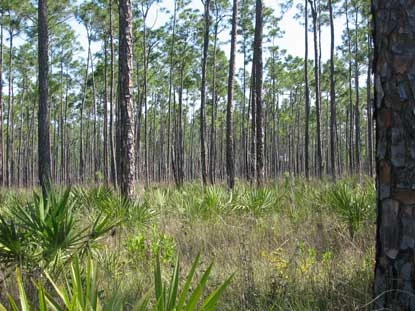
The Pine Rocklands, also called the Pinelands, have a hard rocky ground, made up of limestone. The saw palmetto, is a palm that covers most of the ground space of the Pinelands. It has sharp little teeth along its leaves and stalk, which can cut your legs if you're not careful. You'll notice that the palm leaves all radiate from the center, like a star, on a long stalk or stem. Now take a look at your hand, does it remind you of this plant? The palm of your hand looks very similar to this palm plant. Almost like the palm is giving you a high five! 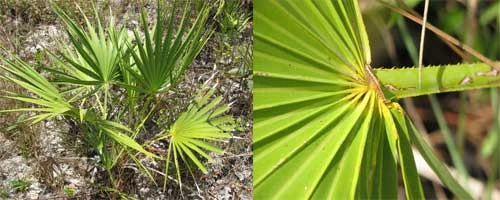
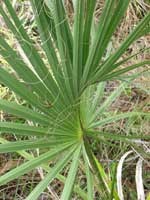
Sometimes called the cabbage palm, the sable palm was used for food by the Native Americans of this area. The edible part is located at the very heart of the palm; however, once removed, the plant dies. The leaves of the sable palm branch off of the main rib that extends from the branch like a spine. The palm leaves also tend to develop stringy fibers on their leaves, making it easier to spot this palm from a distance (see the picture). It is also the state tree of Florida. 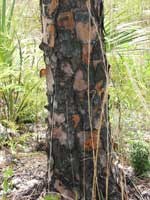
The pinelands are very open, with a lot of open space and only a little bit of shade. All of the vegetation is low to the ground making it easier to see into the distance (though not as easy as it is in the sawgrass prairie). So is fire a good thing or a bad thing for the pines in this habitat? If you said a good thing, then you are CORRECT! It is tempting to say that fire is always bad, but in some cases fire can do a lot of good. Pines need space and a lot of sunlight to grow properly. If other trees, like the leafy hardwoods, start to grow in their space, it becomes too shady for the pine seedlings to grow. It’s also much harder for the pine seeds to sprout. Without fire, this pineland habitat would become overgrown and thick with vegetation, grasses, and hardwood trees. Eventually, the pines would die off and the pineland habitat would change into a hardwood hammock habitat. This process is called forest succession. However, with the help of small fires the pine trees don’t have to compete for space and sunlight with the hardwoods because the hardwoods are not as well adapted to the presence of fire as the pines. We need both the Pinelands and the Hardwood Hammock to have a healthy and good Everglades National Park. 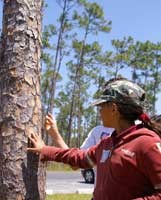
The Pine Rockland ecosystem is well adapted to the presence of fire. As long as the fire is not too intense, the pine trees in the Pinelands remain unharmed. Here are some pine tree adaptations for fire:
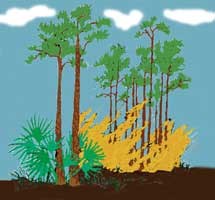
So how do fires start in the pinelands in the first place? Fire comes to the pinelands in two ways:
Since the pinelands need fire to remain healthy, a crew of park rangers trained in fire safety and management will set a series of small planned fires in the pinelands. These planned fires are set under very controlled conditions. Before a prescribed burn can be started, the rangers have to check many different factors that could affect the fire, such as: wind speed, temperature, time of year, the presence of plant and animal species, park visitors, and much, much more. Only a true fire professional who has special permission, is fully trained, and certified in setting prescribed burns may set a controlled fire like the one described above. You can learn a lot from your pinelands Florida State Facts!
All of these plants and animals can sometimes be spotted within the pinelands. You may see them if you’re really observant and a bit lucky too. To return to the previous page click on Habitat and to return to the main |
Last updated: April 14, 2015
